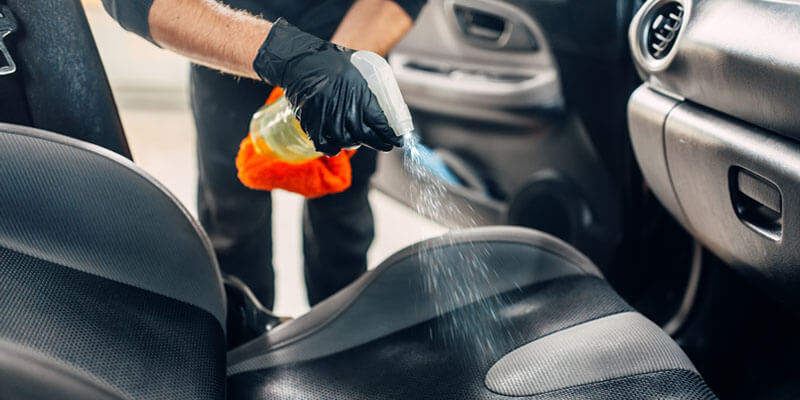If you come in contact with Poison Sumac or Poison Oaktree, you are likely to attract the oil resins termed urushiol. These oily residues are very poisonous and cause itchy and allergic reactions to a person’s skin.
Poison ivy is known to last on surfaces for years, and when affected, the rash can last for a month or two. The worst thing is it can also contaminate car interiors and seats in many ways.
This can turn out to be a catastrophic situation for car owners. They must know how to clean poison ivy off the car seat to make their journey free from irritation.
Can Poison Ivy Get on Car Seats
People get confused about how poison ivy can end up in a car seat. Well, the truth is it can get to your car seats in many different ways. The most common contamination process is when you go to a place surrounded by poison oak plants and catch up the residues on your clothing, boots, and skin.
After that, if you go inside a car without treating the poison ivy, you will certainly ruin the interior by coming in close contact with the seat covers and other parts like steering wheels, dashboards, and such.
How to Clean Poison Ivy from Car Seat
Once you know that your car interior, like seat covers, is flooded with patches of poison ivy residues, you must treat them right away. The cleaning job is not an impossible task, but it does require some patience and precaution to efface the surface properly.
If you don’t treat the contaminated area, you are likely to get caught up in a severe allergic reaction. Below are some steps that can help you with the cleaning process –
Step 1: Gather All Cleaning Tools and Materials
To start, you will need a few basic cleaning equipment and solutions to tackle the harmful oily substance. You just don’t go on to wipe the affected surface; this will increase the chances of spreading. So, you must know what gears and solutions to use for countering poison ivy safely.
What You Need
- Vinyl gloves
- Laundry detergent or liquid laundry detergent
- Leather cleaning solution
- Microfiber towel
- Cloth
- Bristle brush
- Washing machine for removable fabrics (not leather)
Step 2: Safety Precautions
Poison ivy is very dangerous and might excessively affect your skin, so you must wear protective gear while you plan to clean it off the surface. Get a pair of vinyl gloves or heavy-duty cotton gloves.
This should protect your hand and wrist from being exposed to the potent ivy oil. The good thing about vinyl and cotton gloves is that they can be washed using hot water and soap or by tossing the cotton gloves in the washer.
Step 3: Remove Any Detachable Fabric
Your car seats could be made of varying materials; leather seat covers must be treated differently from cloth covers. If you have any detachable clothing covers, you must remove them and wash them separately in a washer. We will discuss both cleaning methods in the later section.
There is more to it than you might think; seat covers come in different variations and models, and they have different ways of installation and detaching procedures. To know more about car seat covers, please follow this link.
Step 4: Covers Should Go into the Washer
The best way to treat affected clothing is to throw them in the washing machine. There is a catch to it. You need to maintain the temperature and the mildness of the detergents to attain a perfect cleaning.
Step 5: Set Up the Washer
The washing machine setting must be something that doesn’t ruin the clothing line. It has to be put up at a comfortable temperature, not too scorching hot that ruins the fabric. However, you will eventually need hot water agitation to fight the oily residues.
We advise you to keep a high temperature but make sure it is sufficient for your clothes. Tweak the washer load size so that it gets the proper swirl inside the washing compartment depending on how many pieces of clothing you have put inside.
You have to use regular laundry detergent as the cleaning solution. Please don’t use any harsh chemicals as they will deteriorate the fabric.
Step 6: Start Washing
Once all the settings are done, you must start the machine and let it do the cleaning for you. When the first round is complete, add more detergent and give it a second wash. If you find the urushiol to be adamant, being clingy on the clothing, then give it the third round following a similar technique.
Step 7: Air Dry
You are almost done; all you need to do is take the seat covers and place them on the drying rack to let them air dry. Don’t use any kind of blowers; rather, let it sit and dry out automatically. Once it’s dry, you can put the covers back on the car interior.
When you are done with the washing machine, be sure to clean it as well. Perform a cleaning cycle on the washer and wipe the outside area with water and chlorine bleach. This should help reduce contamination.
For Leather Seat Covers
Now, if you are dealing with leather goods, you have to go by different routes to clean them. You cannot put a leather cover inside a washer; it will damage every bit of it. Even the temperature can wrinkle the overall seat cover. So, what can be done? Check out the steps below –
Step 1: Wear Safety Gears
No matter the kind of seat cover fabric you have, if you are dealing with poison ivy, you must use protective gloves to keep away from interacting with the residues.
Step 2: Apply the Mixture
For leather, it’s best to use liquid laundry detergent and water mix. You can spray the mixture on the surface and where it’s most vulnerable. We say it is wise to apply the mixture to the whole seat cover, as you don’t know where the oil substance is hiding.
The quantity of mixing should be 5 parts of water to 1 part of detergent. As for aftermarket cleaners, you can use leather cleaners and conditioners apart from the detergent mix, just like Chemical Guy’s complete leather care kit. Keep in mind you must use microfiber towels to wipe off such formulas.
Step 3: Brush it Off
After applying the detergent and water, you must use a soft bristle brush to dig out the residues. Use extra pressure if needed to take off the sturdy residues. Make sure not to scrape the surface by going too harsh on the brushing technique.
Step 4: Rinse and Dry
You are here at the last stage. After applying and removing the grimes with a brush, all you need to do is rinse the seat cover again with a water-soaked towel. Now you have to let the covers dry out by themselves. Remember not to park your car in a sunny area when cleaning leather seat covers.
FAQ
When you put your washer on the hottest setting and use laundry detergent as a cleaning solution, poison ivy residues should not survive a thorough wash. This is one of the efficient ways to kill poison ivy. If you still see some oil patches, you can always re-wash them in the washer.
Clorox wipes will remove poison ivy or oily substances from any hard surfaces and even seat covers. It is not suitable for use on the skin.
You should wash the affected area immediately with rubbing alcohol, dishwashing soap, or poison ivy wash. Leaving it untreated will cause severe rashes and contaminate every place you visit, even your car.
Conclusion
Having itchy infections and rashes from car seat covers is what drivers hate the most. There are many potential reasons behind this, and one of them is the contamination from poison ivy.
If this is the case, then knowing how to clean poison ivy off the car seat is your only solution for maintaining a safe and healthy environment. Follow the article to know the proper way to treat poison ivy spotting from car seats.


